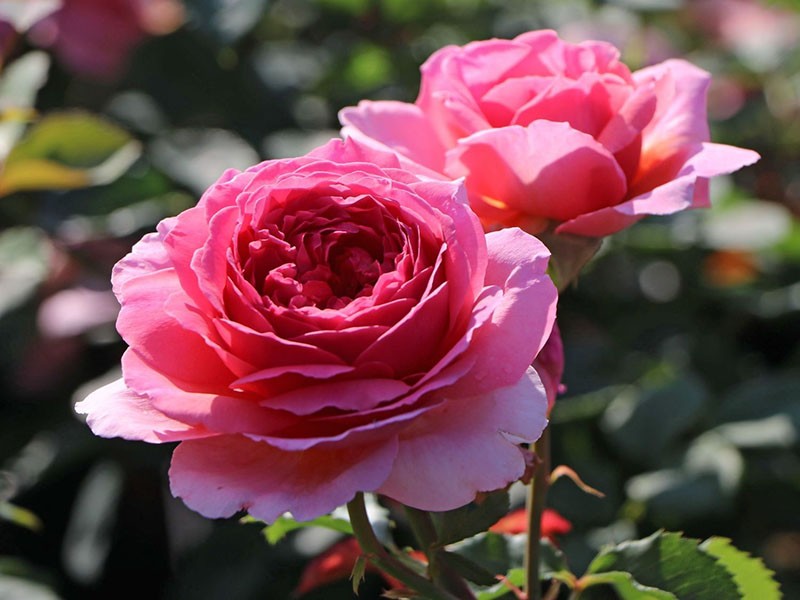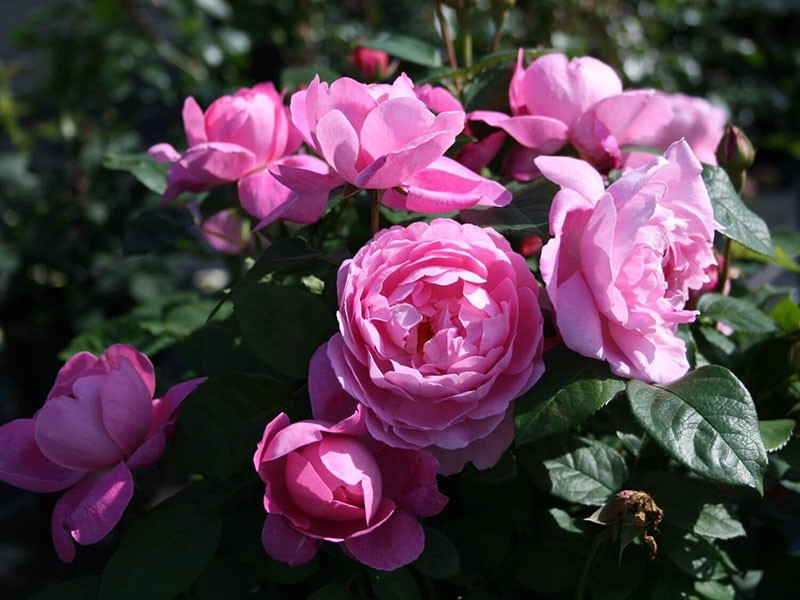How to grow an English beauty rose Mary Rose in your garden
 Rose Mary Rose is one of the most beautiful English varieties from the collection of the famous breeder David Austin. He sought to bring out flowers that in appearance resemble old varieties, but have fundamentally new properties - long re-flowering, harmonious and proportional bush shape, high resistance to frost and disease. These requirements are exactly met by the rose Mary Rose (Mary Rose).
Rose Mary Rose is one of the most beautiful English varieties from the collection of the famous breeder David Austin. He sought to bring out flowers that in appearance resemble old varieties, but have fundamentally new properties - long re-flowering, harmonious and proportional bush shape, high resistance to frost and disease. These requirements are exactly met by the rose Mary Rose (Mary Rose).
Description and quality of the Mary Rose variety


Description of the rose Mary Rose:
- Perennial, proportionally developed, powerful bush, reaching 1.1-1.4 m in height. Plant diameter - up to 1 m.
- The bush consists of a large number of erect, medium leafy stems with sparse thorns.
- Flowers are large, double, up to 8-12 cm in diameter. Inflorescences are cupped and consist of 4-6 blossoming buds.

- The flower consists of 45-55 petals. Their color depends on the growing conditions, most often in light pink shades.
- At the beginning of flowering, the buds have a bright, rich pink color, which turns pale as it blooms.
- Roses have an expressive honey aroma with light almond notes.

One of the main features of the Mary Rose is its early and wave-like flowering - it begins in the first half of June and lasts until mid-July. The second wave of flowering begins in late July or early August and lasts until the first frost.
Rose Mary Rose - growing rules
 Planting and caring for Mary Rose is easy and simple, so this variety is very popular among both experienced and novice florists. Planting can be done in mid-April or in autumn, in October.
Planting and caring for Mary Rose is easy and simple, so this variety is very popular among both experienced and novice florists. Planting can be done in mid-April or in autumn, in October.
 To grow a Mary Rose rose, it is best to choose an area with loose, fertile soil in which moisture does not stagnate. But the English variety grows well on depleted soils, so it can be called universal.
To grow a Mary Rose rose, it is best to choose an area with loose, fertile soil in which moisture does not stagnate. But the English variety grows well on depleted soils, so it can be called universal.
The Mary Rose variety belongs to shade-tolerant varieties, so it is advisable to plant it in partial shade. Direct sunlight can burn the delicate petals, resulting in shorter blooms.
Planting a seedling
 It is best to buy a Mary Rose seedling from specialized flower nurseries. After buying it, you need to carefully examine it, carefully cut off dry, damaged and rotten roots. Then the root system of the rose must be soaked for several hours in a solution of a growth stimulator - Epina, Zircon, Heteroauxin.
It is best to buy a Mary Rose seedling from specialized flower nurseries. After buying it, you need to carefully examine it, carefully cut off dry, damaged and rotten roots. Then the root system of the rose must be soaked for several hours in a solution of a growth stimulator - Epina, Zircon, Heteroauxin.
Rose planting technique:
- Planting holes must be prepared in advance - their diameter should be at least 50-60 cm.
- A drainage layer should be poured into the bottom of the planting hole - for this purpose, you can use broken brick or small crushed stone.
- On top of the drainage, it is necessary to cover the garden soil mixed with compost or humus.
- After that, you need to lower the seedling into the hole and gently straighten the roots.

- The grafting site should be buried in the soil by 9-10 cm.
After that, the aerial part of the rose bush should be spud and watered abundantly.  When planting several plants, leave a distance of at least 1 m between the planting holes. Roses have a fairly massive and spreading root system, which requires a lot of space.
When planting several plants, leave a distance of at least 1 m between the planting holes. Roses have a fairly massive and spreading root system, which requires a lot of space.
The subtleties of caring for a rose Mary Rose
 For the active growth and development of young seedlings, as well as their lush and long flowering, you need to create comfortable conditions for the rose. She needs timely watering, feeding, pruning and forming a bush. If all conditions are met, the Mary Rose rose will become the main decoration of the garden plot.
For the active growth and development of young seedlings, as well as their lush and long flowering, you need to create comfortable conditions for the rose. She needs timely watering, feeding, pruning and forming a bush. If all conditions are met, the Mary Rose rose will become the main decoration of the garden plot.
Watering
 When growing a rose of the Mary Rose variety, the soil under the bush should not be allowed to dry out. It is best to water the plant in the late evening, after sunset, pouring at least 6-7 liters of water under each bush. Young seedlings must be moistened at least 2 times a week.
When growing a rose of the Mary Rose variety, the soil under the bush should not be allowed to dry out. It is best to water the plant in the late evening, after sunset, pouring at least 6-7 liters of water under each bush. Young seedlings must be moistened at least 2 times a week.
For long-term moisture retention, you can form a small mound of earth around the rosebush and sprinkle it with pine needles, chips or cut grass. This mulch will maintain the optimum moisture and temperature for the root system.
Do not water the rose too often when the soil around the bush is still damp. Stagnant water can lead to rotting of the plant root system and cause its death.
Top dressing
 For abundant and long-lasting flowering, Mary Rose needs nitrogen. That is why, before the beginning of the flowering period, it is advisable to feed the plant nitrogen fertilizers.
For abundant and long-lasting flowering, Mary Rose needs nitrogen. That is why, before the beginning of the flowering period, it is advisable to feed the plant nitrogen fertilizers.
In the summer, after the English rose begins to bloom, you can use phosphorus and potassium fertilizers to feed the soil. Instead of complex mineral fertilizers, you can use organic fertilizing - manure, humus.
Pruning and shaping the bush
 It is advisable to prune Mary Rose in the spring, before the flower buds swell. By trimming the plant, you can speed up and enhance its flowering, as well as get the desired shape - climbing or compact.
It is advisable to prune Mary Rose in the spring, before the flower buds swell. By trimming the plant, you can speed up and enhance its flowering, as well as get the desired shape - climbing or compact.
 The formation of a bush can begin immediately after planting. To give a climbing shape, all small, weakened and lateral shoots are cut off. To obtain a compact bush shape with many new shoots and a large number of flowers, 2/3 of the plant height is removed.
The formation of a bush can begin immediately after planting. To give a climbing shape, all small, weakened and lateral shoots are cut off. To obtain a compact bush shape with many new shoots and a large number of flowers, 2/3 of the plant height is removed.
In autumn, after the end of flowering, a sanitary pruning of the rose is carried out - all damaged and diseased shoots are removed.
 Rose Mary Rose is one of the most popular and beautiful varieties of English selection. This plant stands out among other species for its luxurious appearance and excellent aroma, long flowering period, strong immunity and ease of growing.
Rose Mary Rose is one of the most popular and beautiful varieties of English selection. This plant stands out among other species for its luxurious appearance and excellent aroma, long flowering period, strong immunity and ease of growing.